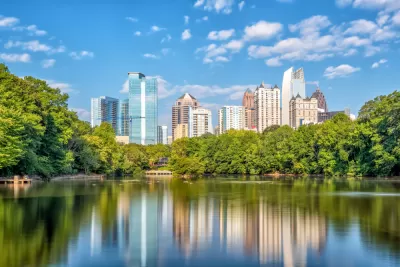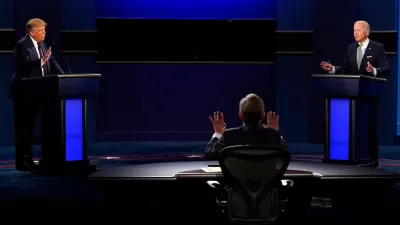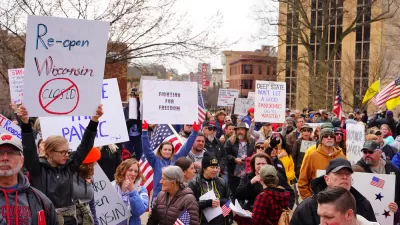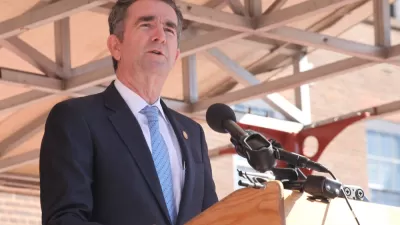Ronald Brownstein, a senior editor at The Atlantic, coins a new political-geographic term in the wake of the Georgia U.S. Senate runoff elections to describe a shift in the political alignment of nearly all large metropolitan areas in the nation.

"In a state that hasn’t elected a Democratic senator since 2000, Democrats now appear to have elected two on a single day by dominating the largest population centers, particularly the Atlanta metropolitan area, with the help of powerful turnout among Black voters," writes Ronald Brownstein, a senior editor at The Atlantic, on Jan. 6.
The electorate’s strong movement toward Democrats in more populous places allowed the longtime pastor and activist Raphael Warnock to oust the GOP Senator Kelly Loeffler, and also propelled fellow Democrat Jon Ossoff to a relatively narrow but likely insurmountable lead over the Republican Senator David Perdue.
Brownstein, also a CNN senior political analyst, goes on to examine the demographic underpinnings of the historic election, but first, some background.
The two runoff elections, held on Jan. 5 as a result of no candidate receiving at least 50% of the vote on Nov. 3, 2020, resulted in narrow victories for both Democratic challengers.
"Warnock will make history when he becomes Georgia's first Black senator and the first Black Democrat to represent a southern state in the Senate," notes CNN. Ossoff will become "the first Jewish senator from Georgia and will be the youngest sitting U.S. senator at age 33," notes NPR.
It will take several days for the Georgia runoffs to be officially certified, so they will not take office immediately. Warnock's term lasts only two years, but Ossoff has won a full six year term in the Senate.
The Senate would be evenly divided between Democrats and Republicans, but once sworn in as vice president, Kamala Harris would have the power to break ties for Democrats.
Geographic show-down?
"The Democratic candidates succeeded despite solid majorities, and even relatively large turnout, for the two Republicans in exurban, small-town, and rural areas where Trump remains revered," adds Brownstein, who goes on detail characteristics of the urban-rural political divide. Italics added below.
President Trump has virtually exiled the GOP from the fast-growing, economically dynamic urban centers and inner suburbs in almost every state—powering historic levels of turnout against him among young people and minority voters (despite gains in some Black and Latino communities), and repelling many previously Republican-leaning college-educated white voters.
In effect, as Georgia’s results underscored, Trump has accelerated the emergence of what could be called the blue beltway: a growing Democratic tilt nationwide in the racially diverse, well-educated (and in many cases more religiously secular) city centers and inner suburbs of large metropolitan areas in nearly all corners of the country. That electoral shift predated Trump, but he has significantly intensified it.
The political and economic geographic divide was also evident in November when "Biden won 91 of the country’s 100 largest counties, and though he won only about one-sixth of the nation’s counties overall, his accounted for fully 71 percent of the country’s total economic output, according to calculations by the Brookings Institution," adds Brownstein.
Democrats should be wary, though, because it's "an open question whether this 'revolution' in Democratic strength across the nation’s inner suburbs will stick once Trump leaves the White House," notes Brownstein.
Hat tip to CNN's coverage of Georgia's U.S. Senate runoff election.
Related in Planetizen:
-
Election Post-Mortem: Politics Trumps Public Health, November 9, 2020
-
Election 2019: Changing Demographics Explain Democrats' Victory in Virginia, November 12, 2019
FULL STORY: The Price Republicans Paid in Georgia

Study: Maui’s Plan to Convert Vacation Rentals to Long-Term Housing Could Cause Nearly $1 Billion Economic Loss
The plan would reduce visitor accommodation by 25,% resulting in 1,900 jobs lost.

Alabama: Trump Terminates Settlements for Black Communities Harmed By Raw Sewage
Trump deemed the landmark civil rights agreement “illegal DEI and environmental justice policy.”

Why Should We Subsidize Public Transportation?
Many public transit agencies face financial stress due to rising costs, declining fare revenue, and declining subsidies. Transit advocates must provide a strong business case for increasing public transit funding.

Paris Bike Boom Leads to Steep Drop in Air Pollution
The French city’s air quality has improved dramatically in the past 20 years, coinciding with a growth in cycling.

Why Housing Costs More to Build in California Than in Texas
Hard costs like labor and materials combined with ‘soft’ costs such as permitting make building in the San Francisco Bay Area almost three times as costly as in Texas cities.

San Diego County Sees a Rise in Urban Coyotes
San Diego County experiences a rise in urban coyotes, as sightings become prevalent throughout its urban neighbourhoods and surrounding areas.
Urban Design for Planners 1: Software Tools
This six-course series explores essential urban design concepts using open source software and equips planners with the tools they need to participate fully in the urban design process.
Planning for Universal Design
Learn the tools for implementing Universal Design in planning regulations.
Smith Gee Studio
Alamo Area Metropolitan Planning Organization
City of Santa Clarita
Institute for Housing and Urban Development Studies (IHS)
City of Grandview
Harvard GSD Executive Education
Toledo-Lucas County Plan Commissions
Salt Lake City
NYU Wagner Graduate School of Public Service





























